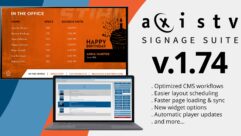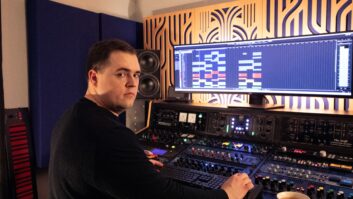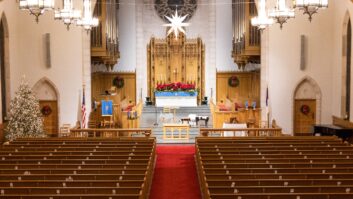
Adding the V to AV for Worship, Part 1
Jul 1, 2010 10:06 AM,
By Bennett Liles
Listen to the Podcasts
|
Editor’s note: For your convenience, this transcription of the podcast includes timestamps. If you are listening to the podcast and reading its accompanying transcription, you can use the timestamps to jump to any part of the audio podcast by simply dragging the slider on the podcast to the time indicated in the transcription.
Related Links

Adding the V to AV for Worship, Part 2
With an existing audio system, the Calvary Lutheran Church decided to expand the video coverage of its services with a PTZ camera, DVD recording, rear-screen projection, and flatscreen monitors. …
The Calvary Lutheran Church in Wilmar, Minn., decided to make the move from an all-audio system to include video displays, cameras, and DVD recording and playback, and they called Graybow Communications. John Gracyalny and Michael Benedetti from Graybow are here to tell us how it all went.
Jon and Michael, thanks for being here for the SVC podcast with Graybow communications. Now, exactly where is Graybow Communications and what does that company do? I know you’ve been on the podcast once before, but in case somebody missed that one.
Gracyalny: Yeah, thanks for having us Bennett. Graybow Communications group is located in Minneapolis, Minn., and we’ve been around since 1996. And we’re really just a small group of seasoned, committed professionals that act like AV contractors. In our team we have everything from front-ending account managers, front-facing account managers, to people that help coordinate things, and we’ve got a system designer that you’ll hear from here—Michael Benedetti—and project managers. And our job really is to just help customers, provide products and services that help them communicate their messages more affectively. And we do that through out the commercial space. We do it on many different verticals. We’ve been very focused on corporate and enterprise, but as we’ll be talking about today, we’ve done tremendous installations in the church and houses of worship market place as well. [Timestamp: 2:02]
Right, you do a lot of churches, which is great. It’s a very strong part of the AV business. You had one in the Calvary Lutheran Church. Now where is that church located?
Gracyalny: Yeah, Calvary Lutheran Church is located in Wilmar, Minn., and Wilmar, Minn., is about a couple of hours away from Minneapolis. But we had a tremendous opportunity here, and they were looking for some key things that we’ve been able to offer churches such as image magnification and better acoustics and things like that, but I’ll let Michael Benedetti, our project manager and designer on the job, tell you a little bit more about some of those specifics. [Timestamp: 2:41]
OK, Michael, when we’re talking about Calvary Lutheran, what style of worship do they have there? What kind of things do they have going on?
Benedetti: Well, the Lutheran church, they’re fairly traditional. They have a band, which most houses of worship have these days. It’s an attraction more for the younger set than the older congregation, but they have a band and they focus on a variety of different ministries there, catering to everything from music, adult, elementary, education and their services are more or less traditional Lutheran. [Timestamp: 3:18]
Obviously, they had something in mind here they wanted to change. What was the AV situation that they had there to start with and what kind of changes did they want you to come in and make?
Benedetti: For the most part, they did not have the “V” part of “A” going on in their church whatsoever. They had an audio system, which suited their needs and we really didn’t do too much to the audio system rather than integrate what we needed to into it. They had no video. They weren’t using any video support or IMAG or anything of that sort. They didn’t even have portable projection that they brought in. And it was a direction that they wanted to go, and they saw this going on in neighboring houses of worship and basically didn’t have any success with it. It keeps it interesting in being able to offer the congregation a little bit more than what’s happening live and to support the message that they’re trying to get out there through video presentation as well. So not having any of the facility or equipment to do that that was their main area focus and the main reason why we got involved in this project was to give them the ability to do that. [Timestamp: 4:36]
Ok, so you guys were going to supply the “V” part, the pictures.
Benedetti: Yes.
And this involved installing several different displays around the church. What kind of displays did you put in and where were they located? What were they going to be used for?
Well, obviously they wanted to go with a wide-screen format, so we basically chose at the front of the sanctuary—to the left and right of the chancel area—we hung two screens in there with rear projection and we focused 5000 ANSI lumens onto those—rear projecting onto them—and those served as the main focal point, the main screens for the sanctuary. In addition to that, there was an area underneath the balcony, which is where the choir and the organ loft is and such, that was far away from the screens, and it had a low ceiling and they referred to it, more or less, as their over-flow area, and so when they did get a large crowd in there and then people had to sit that far back, they wanted them to be involved in what was going on particularly since the new video stuff that they were adding. So we suggested that they add a couple of additional screens under the balcony area there. So what we installed there were two 42in. screens, which pretty much mirror what’s going on on the left and right of the main screens. If you think of moving all the way back and taking that whole concept to a much smaller scale under the balcony, you have the two 42in. screens under there, which allows those people under the balcony to really see what’s going on with their video presentation stuff without having to look way far ahead to the main screens, and so it’s more of an intimate thing there. [Timestamp: 6:40]
Adding the V to AV for Worship, Part 1
Jul 1, 2010 10:06 AM,
By Bennett Liles
OK, and you mentioned rear-projection. I believe you used Pro Display screens and you suspended those. How exactly did you do that and how did you set up the rear screen projection?
Benedetti: Well, on the main far left and right walls of the sanctuary, in the front there, I suspended two Pro Display Pro Diffusion screens. Those are rear-projection substrate screen. The size of those screens was 60×96 in a wide-screen format. What’s nice about the Pro Display screens in that particular model of the screen is that when it’s off and there is no image projected onto it, it basically hangs there in a very non-descript light gray sheet, which is a lot more appealing to our customers when we show them that, particularly for houses of worship to try and get away from that big white block of screen that either comes down electrically or is static. That big white block statically does not work very well in a lot of houses of worship. It’s OK when there’s something on it, but when there’s not, architecturally there are very few churches, particularly houses of worship, that that sort of scenario fits into. So the Pro Display Pro Diffusion screens fit that bill really well.
Related Links

Adding the V to AV for Worship, Part 2
With an existing audio system, the Calvary Lutheran Church decided to expand the video coverage of its services with a PTZ camera, DVD recording, rear-screen projection, and flatscreen monitors. …
There’s another interesting fact about that particular model screen that helped drive this: It’s the fact that that screen’s reversible in a rear-projection application. It has a shiny side and a matte side. If you put the shiny side toward the audience, the picture quality is really phenomenal. It mimics looking at a large plasma display. It’s just brilliant. The only drawback to that in certain applications is like plasma displays, you have that glossy surface there which is prone to reflections. In this particular situation, one whole wall of this sanctuary was stained glass, so you can imagine the reflections that would come in from that onto the screens. We experimented with putting the shiny side out and reversing the screens and putting the matte side out. By putting the matte side out, it virtually eliminated all the reflections on the screen. The trade-off was a little bit softer image than you would have if you put the glossy side out but certainly not a compromise in any respect. It’s still a very nice sharp picture and it solved all their problems with reflections coming in through their stained glass, which they loved the ability for us to offer them those options. We actually, when we went in to do the installation, had one of the screens hanging shiny side out, one hanging matte side out and let them make the decision as to which direction they wanted to go, and that’s a nice option to be able to throw out there to them. [Timestamp: 10:01]
Well, that’s always a good thing. I figure clients like it when you can give them something of a choice they can actually see in front of them and then you can let them decide which way they want to go.
Gracyalny: Yeah, what was really neat about these screens too, Bennett, is that we were able to custom design the way that they were hung. We used a rear-bottom extrusion bar on the top and bottom of the screen and then we used clips and fixtures, metal hardware, along with aircraft cable to suspend the screens so they appeared as if they were floating in the sanctuary. [Timestamp: 10:31]
Now how do you control those projectors? Those were Sanyo projectors, right?
Gracyalny: They were the wide screen WXGA 5000 lumen.
Benedetti: They wanted to keep their system really simple and there were budgetary factors involved. We did not put a traditional touch-pad-type control system in there. It really didn’t warrant it number one, and they would rather put their available funds elsewhere. So for control of the projectors, we chose to simply extend the included handheld remote controls back to the video control center and rather than use those remote controls in the IR mode, they actually became hard-wired remotes to the projectors that were available at the video control center, and it gave them complete control of the projectors for a very, very minimal cost. [Timestamp: 11:34]
Kept the cost down, and it also gave them something, I would imagine, they were much more familiar with.
Benedetti: Correct, and it has all the benefits of your standard remote control that would come with the projector that everybody is comfortable with any ways, along with the reliability of a hard-wire running between it and the projector so you are not relying on infrared technology. [Timestamp: 11:57]
And you put some flatscreen monitors up there. Of course, you had to get signal to those. What format signal did you run on the video and were there any problems running cabling and stuff like that to them?
Benedetti: Running the cabling to all of those displays, we opted to go with more of a traditional RGBHV signal distribution set up, and part of that was in fact budgetary and part of it was that from a wiring stand point and distribution stand point, it was a very simple thing to accomplish. In any house of worship, there’s always a, in a retrofit situation, a challenge of getting those cables from point A to point B without really impacting the architecture of the actual structure there. What we do and we’ve had pretty good success with this in the houses of worship—and we’ve been fortunate, they’re not all like this—but we’ve been fortunate in that most of the houses of worship, particularly the older ones, that we seem to run across do have basements in them where they hold events, and having a basements below the sanctuary gives you an ideal cable path to get from the back of the sanctuary up to the front of the sanctuary or wherever you really need to go without actually having those cables run within the sanctuary. What’s involved in that is onsite technical visits and coordination with the electrical contractors in the area who are working on the project. It involves putting in the core drills between the sanctuary level down to the basement, but once you have those core drills between the two floors, it’s just simply a matter of dropping the cables down from the sanctuary level and dropping them down to the basement level, running them where they need to go and then coming back up into the sanctuary. It makes for really clean installs and really brings down the installation costs as well. [Timestamp: 14:11]
It’s great that you have a basement or some other area that you can get into rather than some modern and very economical church design where they’re on a slab or something.
Benedetti: Here in Minnesota, we get a lot of severe weather out here. Most of those churches, particularly the old ones, were built with that in mind to have those cellars to go to in the event of weather conditions. Most of them do have basements here. [Timestamp: 14:38]
You’ve got some control racks. Now where did you put the racks and what all is in those?
Benedetti: To be honest with you, there’s not really extensive rack mounted equipment on this job. We wanted to keep the control out of sight, so we opted to put that upstairs in the balcony where the choir is and the organ player and such. And what we did, rather than traditional equipment racks, we set them up with more of a video editing type furniture that you would typically find in an editing suite, which is more desk oriented with built-in racks and places to put your monitors and your control equipment and more of an ergonomic set up that is more conducive to being comfortable and using the equipment rather than have it just be staged in racks and have a industrial look to it. [Timestamp: 15:42]
OK, sort of like a multimonitor workstation type of thing?
Benedetti: Exactly. All the control is literally taken care of by one operator who sits at a desk. He has all of his monitors in front of him and everything that he needs to get to is within arms reach right in front of him on the base of this desk with all the outboard gear that does not necessarily need to be handled for the live presentation being in racks below that. [Timestamp: 16:16]
All right, so that sounds like you probably didn’t have a whole lot of problem running power to all that and having to have a lot of power to operate a lot of stuff.
Benedetti: No, having it set up like that actually really simplified the power distribution in there because everything, rather than having a control center and head-end racks, it’s all in one place. So in terms of powering up the actual system, it literally takes place, with the exception of the monitors and projectors, in one location. [Timestamp: 16:50]
Well, of course, it’s always a challenge to hold the costs down and still meet the clients’ expectations, keeping it simple so you don’t have to go back and make a lot of changes. It’s been great having you both here, John Gracyalny and Michael Benedetti of Graybow Communications on the Calvary Lutheran Church installation. In part two we’ll get more into the DVDs, the Xantech control distribution, and the Vaddio PTZ camera. Thanks for being here for part one.
Thanks Bennett. Thanks for having us.









